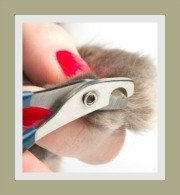About Feline Roundworms
The Signs, Treatment and Prevention
Feline roundworms are intestinal parasites that inhabit the intestines of your cat. Roundworms are classified as nematodes and are generally considered the most important of the feline intestinal parasites.
Roundworms are endoparasites, a term used to describe an organism that lives in a host (in this case the cat's intestines) where it feeds, derives nourishment and reproduces.
Roundworms do not attach themselves to the intestinal wall like hookworms and tapeworms.
There are other important cat worms; these are the group known as cestodes or feline tapeworms.
In the chapters that follow we will also provide some insights into the other feline intestinal parasites - lungworms, heartworms and a protozoan parasite called toxoplasma gondii.
types of cat roundworms
|
There are 2 types of cat round worms:
|
 |
1. toxocara cati | cat roundworm
This feline roundworm is considered the most common and most critical of the roundworms (aka ascarids) and it is believed to infest more than 25 % of all domestic cats, especially kittens.
This cat worm has a white to cream-colored body; it is about 6 inches (15 cm) long and is pointed at both ends.

2. toxascaris leonina | cat roundworm
This feline roundworm, although less common than Toxocara Cati, is very similar in appearance.
Your cat can become infested by this roundworm by ingesting infective eggs.
Once ingested, the larvae emerge and develop into adult worms. Unlike T. Cati, the larvae does not travel around the body and does not infest the mammary glands or the milk of nursing queens.
Kittens younger than 6 months will generally not be infected by this round worm.
If your cat is free-roaming and hunts for food, Toxocara Leonina can be acquired from rodents or birds that are infested by this roundworm.
how your cat becomes infested with roundworms

For a better understanding, let's start with the life cycle of this intestinal parasite.
The adult, female cat roundworm inhabits the small bowel of your cat where it feeds and produces microscopic eggs which are later passed in the feces.
After a couple of days these eggs embryonate, developing infective larvae inside the eggs. (It takes about 3 weeks for the larvae to become infective).
If your cat ingests these eggs (e.g. whilst eating grass), the larvae will be expelled from the egg into the intestine of your cat.
From here
the larvae will travel around your cat's body, via the liver and lungs.
(The larvae is often coughed up and then swallowed again and then
returns to the small intestine where it matures and lays eggs).
In older cats in particular, the larvae lies dormant in tissues and causes no ill effects.
In
other instances, the larvae may travel to the mammary glands of a
nursing queen.
Sadly, immature cat round worms are then found in the
milk and are passed onto the kitten during lactation. The worms will
mature in the kitten's small bowel where they lay eggs that will
eventually be passed in the kitten's feces.
Very often, infected
feline roundworm eggs are ingested by rodents, birds, beetles and
earthworms.
In this case, the juvenile round worms emerge from the eggs and travel around the prey's body tissues where they lie dormant.
Free-roaming cats will become infested with roundworms when they ingest raw prey such as rodents and birds. (Cats do not eat worms and beetles, but birds and rodents do and this is how prey also becomes infested).
feline roundworms symptoms
In an adult cat there are seldom any signs that the cat is infested with round worms. (This is possibly due to the fact that adult cats do not carry a large number of worms).
The problem with adult cats is that they do pass a significant amount of eggs into the environment thereby re-infecting other cats.
A kitten that is infested with roundworm presents with a range of signs and symptoms. If left untreated, the kitten can become gravely ill.
- Kittens infested with Toxocara Cati may vomit a large spaghetti bundle of worms. These roundworms, which are 4 inches (10 cm) in length, are similar in appearance to earthworms.
- Diarrhea may accompany the vomiting and worms may be present in the feces.
- General lethargy
- In heavy infestations, the kitten will present with a pot-belly and this is due to the build-up of gas in the intestines.
- The kitten will be constantly hungry and wolf their food down, but with no resultant weight gain.
- Weight loss
- Anemia
- Coughing
- The kitten's coat looks dull and unkempt
cat worm treatments
Your first port of call should always be your veterinarian.
The veterinarian will give your cat a thorough physical examination.
A stool sample will be taken and microscopically examined to confirm the diagnosis.
The vet will affect the appropriate treatment, prescribe the correct de-wormer and provide advice on how to minimize re-infestation.
Note: You can of purchase de-worming remedies without a veterinary prescription BUT you need to be sure that you are using the correct medication for the relevant intestinal parasite.
Do not use canine de-wormers for your cat. Human worming remedies should not be given to your pets.
The veterinarian will provide instructions regarding the dosage of the particular de-wormer.
Generally speaking, you can start de-worming your kitten around 6 weeks and repeat every 3 weeks thereafter until your kitten is 4 months old.
It is recommended that you de-worm your cat every 3 - 4 months.
Pregnant and lactating queens can and should be treated with de-wormers.
| Active Ingredient | Trade Name + Company |
| Praziquantel, pyrantel pamoate | Drontal Cat Tablets (Bayer) |
| Milbemycin and Praziquantel | Milbemax (Novartis) |
| Praziquantel | Droncit Feline Tablets (Bayer) |
| Emodepside and Praziquantel | Profender Topical Solution (Bayer) |
| Fenbendazole | Panacur (Intervet) |
humans and feline roundworms
Children are more likely to become infested with cat roundworms than adults.
Children generally come into contact with the eggs whilst playing in the garden. It is for this reason that parents should encourage good hygiene practices like hand washing.
Your pets (dogs and cats) should not be permitted to enter areas like sandboxes or areas designated as children play areas.
You need to keep cat litter trays clean and also remove feces from the garden promptly.
Your pets must be de-wormed regularly to prevent infestation of roundworms. Keep your pets bedding, pens and runs clean by disinfecting with boiling water or steam sterilization.
Note: Cat roundworms generally do not cause problems in humans.
Having said this, in rare cases, serious damage to the organs like the lungs, liver and brain can occur as a result of the inflammation caused by infected larvae circulating around the body. This process is call visceral larval migrans.
If the larvae reach and settle in the eyes,
this may cause disturbances in vision and vision impairment. (Roundworms
found in dogs are a greater risk to humans than feline roundworms).
We highly recommend that all pet owners consider de-worming themselves at least twice a year.
Speak to your doctor about the appropriate preventative treatment for adults and children.
Related Pages:
Top of Feline Roundworms Page
Return to Worms in Cats
search our site
please like us
share our site
recommend on google
favorite pages





